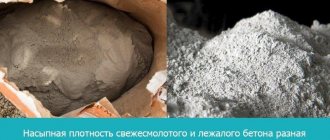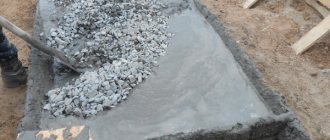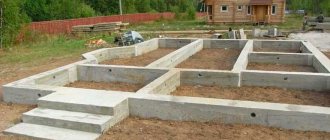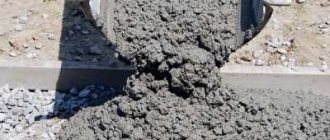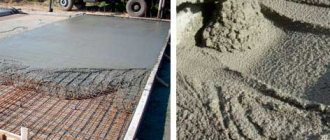Concrete is one of the most versatile and common materials for pouring foundations. Its preparation is fraught with a number of difficulties, in particular, maintaining proportions and choosing high-quality ingredients for preparing the composition. In this article we will try to outline a number of recommendations that can help you make the optimal solution for the foundation with your own hands, using the most commonly used measuring unit - a bucket.
How many kg of sand are in a 12 liter bucket?
The weight of dry construction sand (this figure is taken as a guide in construction work) is 18.4 kg in a 12-liter bucket. If this is river sand (again, dry), then its weight is 18.3 kg. If the sand is wet (river), then the bucket can contain 20 kg or even more.
Interesting materials:
What color is the 1978 horse? What animal will 2022 be? Which iPhone is popular in 2022? What is the best iPhone of 2021? What ensemble did Alexander Alexandrov create in 1928? What will the year of the Ox be like for those born in the year of the Dog? What will the minimum wage be from January 1, 2022? What was the dollar exchange rate in September 2022? What was the dollar exchange rate in Ukraine in 2008? What day is October 31, 2020?
M150 (B10)
This brand is suitable for constructing screeds, floors or foundations for light buildings on good soils. It can also be used to pre-level foundation pits before pouring stronger structural concrete.
Composition of concrete mix M150:
| Cement brand | Cement, bags | Sand, buckets | Crushed stone, buckets | Water, buckets | Concrete yield, liters |
| 400 Ш II/А-Ш 32.5 B | 1 | 6 | 14 | 4 | — |
| 400 Ш II/А-Ш 32.5 N | 1 | 7,5 | 12 | 3,5 | — |
| 400 W II/H-W 32.5 N | 1 | 11,5 | 16,5 | 4 | — |
| 500 I 42.5 N | 1 | 13 | 17,5 | 4,5 | — |
| 500 II/A-Sh 42.5 | 1 | 11 | 14 | 4 | 210 |
Choose proportions so that the volume of mixed components fills no more than 50% of your concrete mixer. Otherwise, there is a high risk of improper mixing and substandard quality.
For example, with a 120 liter mixer, reduce the amount of all ingredients by 4 times from those indicated in the table. In this case, the volume of the finished concrete mixture will be about 50 liters, and the concrete mixer will easily mix it. For mixers with a volume of 190-220 liters, the amount of fillers should be halved. As a result, the yield of concrete mixture will be 105 liters.
Online calculator
To calculate the proportions of the concrete mixture, use the online calculator.
Some people prefer to do this with a shovel, but this tool does not provide sufficient efficiency, which affects the quality of the result.
If you still have no choice, then you can use the equipment described above, but make sure that it is absolutely dry, like the kneading bucket. All materials are measured using buckets, and then compacted well and leveled with a shovel. To make it convenient to work with the mixture, you will need a capacious container. We mix sand and crushed stone, make irregularities on the surface of the mass, into which we pour cement. Mix all components thoroughly until a homogeneous consistency is obtained.
Work on pouring the foundation should be carried out in the warm season so that it does not begin to freeze, and the resulting ice crystals do not begin to destroy it from the inside.
Thus, we have considered the proportions and composition of concrete, as you can see, everything is quite simple. It is only important to take into account some subtleties and have some dexterity when kneading. Carefully study the composition of the materials you buy and their properties, then you will be pleased with the result. Even if you miss something somewhere and end up with concrete of a lower grade than you planned, it will be quite suitable for installing a foundation for a house or gazebo.
Cement proportions for foundation
Almost all low-rise and most high-rise buildings in Russia stand on strip or block foundations made of heavy concrete. This is not surprising, given that heavy concrete, due to its plasticity, high load-bearing capacity and affordable cost, is the preferred material for constructing foundations for low-rise and high-rise buildings.
The building structure - the foundation, is its basis, taking on the weight of: walls, roofing, facade cladding, interior decoration, floor slabs and other structures and elements of a private house, cottage, villa or small country house. Therefore, saving on materials for its construction is unacceptable!
The proportions of cement for the foundation, as well as the proportions of other components of concrete for pouring it, must correspond to the accepted brand of concrete. And the accepted grade of concrete must correspond to the load on the structure being built.
M200 (B15)
The recipe for a concrete mixture of grade 200 is suitable for the foundations of small houses, bathhouses and outbuildings. This brand is also used in the manufacture of blind areas, floors, pouring platforms, and concreting fence posts.
Recipe for ready-mixed concrete M200:
| Cement brand | Cement, bags | Sand, buckets | Crushed stone, buckets | Water, buckets | Concrete yield, liters |
| 400 Ш II/А-Ш 32.5 B | 1 | 5 | 12 | 3,5 | — |
| 500 II/A-Sh 42.5 | 1 | 10 | 13 | 3,5 | 190 |
| 500 II/A-3 42.5 | 1 | 10 | 12 | 4 | — |
If you need to calculate the number of ingredients to obtain one cube of the mixture, then here is a recipe for 1 m200 cube of concrete from “five hundredth” cement with slag:
- Cement – 5.3 bags (0.265 tons);
- Sand - 53 buckets (0.795 tons);
- Crushed stone - 68 buckets (1,026 tons);
- Water – 18.5 buckets (0.185 m3).
The proportions are additionally given in tons and will be convenient if the volume of concrete required is known, but you need to calculate how much bulk materials to order.
Component ratios and general recommendations
It is not so easy to understand what ratio of components is optimal, because each building is purely individual, so when building with your own hands, rely on the recommended proportions.
The table you see below represents proportions expressed as fractions, so a bucket works perfectly as a measuring unit:
Table of ratio of cement, sand and crushed stone
The most suitable equipment for mixing concrete of the correct uniform consistency is a household concrete mixer.
Important! Keep in mind that sand contains moisture, so before starting work it must be thoroughly dried or the amount of water reduced in proportion. You should also check the purity of the sand; it should not contain admixtures of clay and silt, or it may contain them in very small quantities. To do this, place a small amount of sand in a container and fill it with water; if a lot of viscous sediment appears, it means it is not suitable for work.
Concrete designations and areas of application
In order to divide concrete into types, alphanumeric designations are used. The first letter is “M”, followed by a number indicating the degree of concrete’s resistance to compression at the time of complete hardening (approximately a month). For example, M400, in this case the resistance is 400 kg/ms2. This means that the larger the digital designation, the more durable the concrete is.
For each type of construction work, a specific grade of concrete is used:
- grades from M100 to M150 are used for pouring under the foundation;
- M200 is the most common option; foundations, floor screeds, retaining walls and roads are poured with this brand;
- M350 is used as a fill for foundations for large structures, as well as for road decks.
- grades with higher performance are already used in the construction of more complex and heavy structures, such as various hydraulic structures, dams and dikes; they are not used in everyday life.
M250 (B20)
This is a suitable recipe for most foundations in private housing construction, as well as pouring fences, monolithic stairs and walls.
The recipe for M250 concrete for a foundation in buckets is as follows:
| Cement brand | Cement, bags | Sand, buckets | Crushed stone, buckets | Water, buckets | Concrete yield, liters |
| 500 I 42.5 N | 1 | 8,5 | 12 | 3 | — |
To make 1 M250 cube you will need the following ingredients:
- Cement – 6.3 bags (0.315 tons);
- Sand - 54 buckets (0.8 tons);
- Crushed stone - 76 buckets (1,134 tons);
- Water – 19 buckets (0.19 m3).
Preparation
Not all craftsmen know how to properly prepare concrete so that all components are thoroughly mixed. It is important to ensure that the consistency of the composition is thick and does not stick.
To solve these issues, it is necessary to clearly know the proportions of the components and the order of loading the concrete mixer. Before starting cooking, it is better to carry out calculations and prepare the ingredients so as not to be distracted during the process.
The procedure is as follows:
- 1/2 part of the water is poured into the container.
- Almost all the crushed stone is filled in, and the concrete mixer is turned on. At the beginning, you need to put crushed stone so that it can cope with breaking up the thick solution in the container. This will avoid clumping.
- The entire volume of cement spills out. Knead the resulting mixture until it becomes homogeneous.
- Now, without stopping the machine, pour out all the sand. At this stage you need to be especially careful and attentive. The resulting composition should look homogeneous without lumps of sand.
- To complete the preparation, the remaining part of the crushed stone is poured into the concrete mixer. When the device thoroughly mixes all the ingredients, the rest of the water is added to the container. After this, the composition is brought to a homogeneous state.
- When the mixture is ready, it must be carefully poured. To do this, the rotating concrete mixer is turned down so that the solution pours into the prepared bucket.
Important! After finishing mixing, it is necessary to wash the concrete mixer. To do this, use water and a trowel. This rule cannot be neglected, even if another batch of concrete is planned that day. Due to the remnants of the old mixture, lumps often appear in new concrete.
The main components of cement mortar are water, sand and cement.
Cement mortar is a viscous mixture that is used to fasten any parts to each other.
The solution can be used in monolithic construction, but here it is necessary to use a higher grade of cement.
The basis of any cement mortar is a combination of essential ingredients:
- actually, cement itself , which acts as a binder;
Cement
- sand acting as a filler ;
Sand
- water is used to dilute dry substances to give them a certain consistency.
In addition to the presence of these basic components, the quality of the cement mortar depends on their quality. There are no specific strict requirements for water, except for its purity. It should not contain unnecessary impurities, dirt, oil, etc.
If there is no water supply system at the construction site, then the best option would be purchased water in stores.
Most experts are inclined to use river sand, which is characterized by the absence of impurities, stones and clay. The use of quarry sand is also allowed, but after preliminary cleaning and washing.
But sea sand turns out to be completely unsuitable for use. The fact is that it contains a large amount of salt, which is difficult to wash out of the composition, which negatively affects the binding of all components of the mixture.
Sea sand
The main element of the solution is cement, the quality of which largely determines the quality of the entire mixture. There are many grades of cement, ranging from 100 to 600.
The higher the number, the greater the load the hardened mortar can withstand, which is a very important indicator in various construction fields.
For the foundation you will need higher grades of cement - M400, M500, etc. But for laying facing bricks, for plastering walls and other similar works, the M100 and M200 brands are quite suitable.
Specifics of concrete mixtures
Cement and water are the most important components that make up concrete; they are responsible for the integrity of the structure and then form the concrete slab. However, during hardening the slab can deform and shrink up to 2mm/m2. In order to avoid cracking and deformation of the cement stone, it is necessary to include sand and crushed stone in the composition (expanded clay and gravel can also be used). These fillers create a structured reinforcement that absorbs the stress of shrinkage. Thanks to this, the concrete becomes stronger and shrinkage errors are reduced.
Users often search for:
- Concrete for foundation
- How to prepare lime mortar
You should not buy cement in advance, as it quickly absorbs moisture in the air, and this reduces its quality properties. Thus, cement purchased six months ago may no longer correspond to its brand and you will not be able to correctly calculate the proportions.


